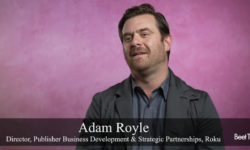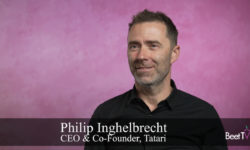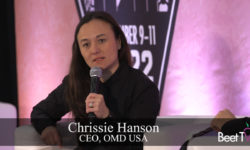SANTA MONICA, Calif. – The past three years were characterized by massive disruption in the television industry as the coronavirus pandemic sped up longer-term trends such as the growth in streaming media. Viewers who were stuck at home during lockdowns signed up for video services to keep themselves entertained — a need that was especially acute for sports fans who didn’t have much to watch as leagues canceled or delayed their seasons.
As companies in the television advertising industry prepare for the next few years, there are several key themes that will shape how marketers, agencies, media owners and ad-tech companies work. Those themes were highlighted in a panel discussion hosted by Jon Watts, editorial director of Beet.TV Events, at the Beat Retreat Santa Monica.
Nicolle Pangis, chief executive of Ampersand
“There has been a lot of progress in the measurement field,” Pangis said, “and I think there are becoming more and more options there.”
While Nielsen works to regain accreditation from the Media Rating Council and launches its Nielsen One product for cross-platform audience measurement, other companies have emerged to help marketers and media owners to understand viewing behavior.
“We’re starting to get much more sophisticated marrying linear addressable, streaming — all the pieces of the puzzle for brands and agencies,” Pangis said. “That actually is the most important piece, because if we start all working together, closer to the buy side, that’s when I think the magic starts to really happen for all of us.”
Dave Morgan, founder and chief executive of Simulmedia
“We’re actually truly seeing an industry that’s focused on what does it mean to be both linear and streaming together?” Morgan said. “That’s become really the mantra of both the companies that own linear TV, but also the streaming companies.”
Looking ahead to the next few years, he said he’d like to see greater emphasis on improving the viewing experience for consumers who watch ad-supported streaming. Frequency capping of ads among multiple platforms would help to avoid showing the same ads to the same audiences too often. Morgan said companies throughout the television industry need to collaborate to better compete with tech giants such as Google, Amazon and Apple whose core businesses are outside of television and video advertising.
“I don’t wanna sound cynical, because I’m not a cynic, but I think there’s probably no bigger driver to collaboration happening today than survival and abject fear,” he said. “There’s nothing like having the fear of those 18-wheelers coming at you to say, ‘Hey, let’s work together so we can survive.’”
Katy Loria, chief revenue officer, FreeWheel
Consumer adoption of ad-supported video on demand (AVOD) channels is positive for marketers that have fretted that they can’t find enough media inventory to reach the audiences they need to engage. Popular subscription video-on-demand (SVOD) services such as Netflix and Disney+ used to offer ad-free viewing, but in 2022 introduced ad-supported tiers for a lower fee.
“I think we all kind of woke up from the pandemic and said, ‘wait a minute, how many of these subscriptions did I sign up for?’” Loria said. “That fatigue that we’re seeing on the SVOD side I think is really playing out nicely on the ad-supported side.”
Adam Gaynor, chief revenue officer at Gamut
Local advertisers are gaining more tools to help them reach custom audiences in specific geographic areas.
“We’re seeing this resurgence in local marketing and local advertising,” Gaynor said. “The ability to hyper-target where audiences are and not just ‘spray and pray,’ but to use both national and local as a complement.”
Sean Buckley, chief revenue officer of Magnite
The media industry has seen more consolidation in recent years, with the merger of Discovery with WarnerMedia, CBS with Viacom and numerous acquisitions of free, ad-supported television (FAST) services such as Pluto TV, Xumo and Tubi. As advertisers seek to work with fewer media partners, consolidation
“We have a smaller number of really large organizations now that we’re focused on,” Buckley said. “On the buy side, this theme of consolidation, buyers wanting to go deeper with a far fewer set of customers — it’s central to the conversations that we’re having.”
You are watching coverage of Beet Retreat Santa Monica 2022, presented by Ampersand, MiQ, Nielsen, PubMatic, T-Mobile Advertising Solutions and The Trade Desk. For more videos from the Beet Retreat, please visit this page.














































